Flood Hazard Analysis Based on Rainfall Fusion: A Case Study in Dazhou City, China
Abstract
1. Introduction
2. Study Area and Materials
2.1. Study Area
2.2. Materials
2.2.1. Rainfall Data
2.2.2. Historical Flood Points
3. Methodology
3.1. Flood Hazard Factors Calculation
3.2. Rainfall Data Fusion Methods
3.2.1. Linear Regression (LR) Method
3.2.2. Kalman Filter (KF) Method
3.2.3. Geographically Weighted Regression (GWR) Method
3.2.4. Optimal Interpolation (OI) Method
3.3. Construction of Flood Hazard Evaluation System
3.3.1. Linear Weighted Sum (LWS) Method
3.3.2. Certain Factor (CF) Model
3.3.3. Flood Hazard Analysis System
3.4. Statistical Metrics
4. Results
4.1. Performance Evaluation of Four Fusion Methods
4.2. Factor Weight Values from RF Model
4.3. Flood Hazard Analysis
5. Discussion
6. Conclusions
- (1)
- For the fusion experiment of three-hour TRMM 3B42 and gauge rainfall from 1998 to 2012 in Dazhou City, the LR method has an outstanding performance, with the lowest MBIAS (0.20) and RMSE (0.10) and an acceptable R (0.56).
- (2)
- The RF model has a great performance in clarifying the weights of the nine hazard indicators, which is reflected in the fact that the PCA values of the cases corresponding to four rainfall durations, i.e., 3 h, 6 h, 9 h, and 12 h, which are all greater than 0.80 during the training period and are maintained at about 0.8 during the testing period. In addition, the most critical flood hazard factor is DEM (topography), followed by DR, while the least important one is FA.
- (3)
- The distribution of the flood hazard in Dazhou City, obtained by the proposed system using the higher-precision fusion rainfall and other eight flood indicators, is reasonable. More than 70% of historical flood points were in high and sub-high hazard zones, and the areas under the ROC curves were all within an acceptable range, 0.7–0.9, which further reflects the reliability of the flood hazard analysis results.
Author Contributions
Funding
Institutional Review Board Statement
Informed Consent Statement
Data Availability Statement
Acknowledgments
Conflicts of Interest
References
- Blais, E. Floods in a changing climate: Risk management. Can. Water Resour. J. Rev. Can. Des Ressour. Hydr. 2014, 39, 375–376. [Google Scholar] [CrossRef]
- Jongman, B.; Winsemius, H.C.; Aerts, J.C.J.H.; Coughlan De Perez, E.; van Aalst, M.K.; Kron, W.; Ward, P.J. Declining vulnerability to river floods and the global benefits of adaptation. Proc. Natl. Acad. Sci. USA 2015, 112, E2271–E2280. [Google Scholar] [CrossRef] [PubMed]
- Hirabayashi, Y.; Mahendran, R.; Koirala, S.; Konoshima, L.; Yamazaki, D.; Watanabe, S.; Kim, H.; Kanae, S. Global flood risk under climate change. Nat. Clim. Chang. 2013, 3, 816–821. [Google Scholar] [CrossRef]
- Tanoue, M.; Hirabayashi, Y.; Ikeuchi, H. Global-scale river flood vulnerability in the last 50 years. Sci. Rep.-UK 2016, 6, 36021. [Google Scholar] [CrossRef] [PubMed]
- Yang, K.; Chen, T.; Ao, T.; Zhang, X.; Zhou, L.; Gao, D. Response of runoff in the upper reaches of the Minjiang River to climate change. J. Water Clim. Chang. 2022, 13, 260–273. [Google Scholar] [CrossRef]
- Brody, S.D.; Zahran, S.; Highfield, W.E.; Grover, H.; Vedlitz, A. Identifying the impact of the built environment on flood damage in Texas. Disasters 2008, 32, 1–18. [Google Scholar] [CrossRef] [PubMed]
- EM-DAT: The OFDA/CRED International Disaster Database, Université Catholique de Louvain, Brussels, Bel. Data Version: v11.08, 2010. Available online: http://www.emdat.be/ (accessed on 6 August 2021).
- Nie, C.; Li, H.; Yang, L.; Wu, S.; Liu, Y.; Liao, Y. Spatial and temporal changes in flooding and the affecting factors in China. Nat. Hazards 2012, 61, 425–439. [Google Scholar] [CrossRef]
- Kundzewicz, Z.W.; Su, B.; Wang, Y.; Xia, J.; Huang, J.; Jiang, T. Flood risk and its reduction in China. Adv. Water Resour. 2019, 130, 37–45. [Google Scholar] [CrossRef]
- Liu Jianfen, Z.X.T.Z. Spatial distribution of flood hazards in China. J. Hohai Univ. Nat. Sci. Ed. 2004, 32, 614–617. [Google Scholar]
- Zhang, J.; Wang, T.; Ge, J. Assessing Vegetation Cover Dynamics Induced by Policy-Driven Ecological Restoration and Implication to Soil Erosion in Southern China. PLoS ONE 2015, 10, e131352. [Google Scholar] [CrossRef]
- Jia, H.; Chen, F.; Pan, D.; Du, E.; Wang, L.; Wang, N.; Yang, A. Flood risk management in the Yangtze River basin—Comparison of 1998 and 2020 events. Int. J. Disaster Risk Reduct. 2022, 68, 102724. [Google Scholar] [CrossRef]
- Song, M.L.; Du, Q.Q. Analysis and exploration of damage-reduction measures for flood disasters in China. Ann. Oper. Res. 2019, 283, 795–810. [Google Scholar] [CrossRef]
- Notaro, V.; Fontanazza, C.M.; La Loggia, G.; Freni, G. Flood frequency analysis for an urban watershed: Comparison between several statistical methodologies simulating synthetic rainfall events. J. Flood Risk Manag. 2018, 11, S559–S574. [Google Scholar] [CrossRef]
- Wang, J.; Liang, Z.; Hu, Y.; Wang, D. Modified weighted function method with the incorporation of historical floods into systematic sample for parameter estimation of Pearson type three distribution. J. Hydrol. 2015, 527, 958–966. [Google Scholar] [CrossRef]
- Bajracharya, S.R.; Khanal, N.R.; Nepal, P.; Rai, S.K.; Ghimire, P.K.; Pradhan, N.S. Community Assessment of Flood Risks and Early Warning System in Ratu Watershed, Koshi Basin, Nepal. Sustainability 2021, 13, 3577. [Google Scholar] [CrossRef]
- Gao, Y.; Zhao, S.; Deng, J.; Yu, Z.; Rahman, M. Flood assessment and early warning of the reoccurrence of river blockage at the Baige landslide. J. Geogr. Sci. 2021, 31, 1694–1712. [Google Scholar] [CrossRef]
- Su, X.; Shao, W.; Liu, J.; Jiang, Y.; Wang, K. Dynamic Assessment of the Impact of Flood Disaster on Economy and Population under Extreme Rainstorm Events. Remote Sens. 2021, 13, 3924. [Google Scholar] [CrossRef]
- Oddo, P.C.; Bolten, J.D. The Value of Near Real-Time Earth Observations for Improved Flood Disaster Response. Front. Environ. Sci. 2019, 7, 127. [Google Scholar] [CrossRef]
- Wang, Z.; Gao, Z. Dynamic monitoring of flood disaster based on remote sensing data cube. Nat. Hazards 2022. [Google Scholar] [CrossRef]
- Sun, T.; Li, R.; Deng, H.Y.; Li, X.T. Flood Disaster Monitoring and Evaluation System Based on GIS and Remote Sensing: Case Study in Hejiang River. Appl. Mech. Mater. 2012, 239–240, 560–564. [Google Scholar] [CrossRef]
- Ding, L.; Ma, L.; Li, L.; Liu, C.; Li, N.; Yang, Z.; Yao, Y.; Lu, H. A Survey of Remote Sensing and Geographic Information System Applications for Flash Floods. Remote Sens. 2021, 13, 1818. [Google Scholar] [CrossRef]
- Yang, T.; Xie, J.; Li, G.; Zhang, L.; Mou, N.; Wang, H.; Zhang, X.; Wang, X. Extracting Disaster-Related Location Information through Social Media to Assist Remote Sensing for Disaster Analysis: The Case of the Flood Disaster in the Yangtze River Basin in China in 2020. Remote Sens. 2022, 14, 1199. [Google Scholar] [CrossRef]
- Li, Q.; Jiang, X.; Liu, D. Analysis and modelling of flood risk assessment using information diffusion and artificial neural network. Water SA 2013, 39, 643–648. [Google Scholar] [CrossRef]
- Michielsen, A.; Kalantari, Z.; Lyon, S.W.; Liljegren, E. Predicting and communicating flood risk of transport infrastructure based on watershed characteristics. J. Environ. Manag. 2016, 182, 505–518. [Google Scholar] [CrossRef]
- Zhu, Z.; Zhang, Y. Flood disaster risk assessment based on random forest algorithm. Neural Comput. Appl. 2022, 34, 3443–3455. [Google Scholar] [CrossRef]
- Li, X.; Yan, D.; Wang, K.; Weng, B.; Qin, T.; Liu, S. Flood Risk Assessment of Global Watersheds Based on Multiple Machine Learning Models. Water 2019, 11, 1654. [Google Scholar] [CrossRef]
- Luu, C.; Von Meding, J.; Kanjanabootra, S. Assessing flood hazard using flood marks and analytic hierarchy process approach: A case study for the 2013 flood event in Quang Nam, Vietnam. Nat. Hazards 2018, 90, 1031–1050. [Google Scholar] [CrossRef]
- Yang, X.; Ding, J.; Hou, H. Application of a triangular fuzzy AHP approach for flood risk evaluation and response measures analysis. Nat. Hazards 2013, 68, 657–674. [Google Scholar] [CrossRef]
- Bachmann, D.; Schuttrumpf, H. Integrating the reliability of flood protection structures into catchment-based flood risk analysis. Hydrol. Wasserbewirts. 2014, 58, 168–177. [Google Scholar]
- Salleh, A.H.; S Ahamad, M.S. Flood risk map (case study in Kelantan). IOP Conf. Ser. Earth Environ. Sci. 2019, 244, 12019. [Google Scholar] [CrossRef]
- Jung, Y.; Shin, Y.; Jang, C.H.; Kum, D.; Kim, Y.S.; Lim, K.J.; Kim, H.B.; Park, T.S.; Lee, S.O. Estimation of flood risk index considering the regional flood characteristics: A case of South Korea. Paddy Water Environ. 2014, 12, 41–49. [Google Scholar] [CrossRef]
- Yalcin, G.; Akyurek, Z. Analysing flood vulnerable areas with multicriteria evaluation. In Proceedings of the 20th ISPRS Congress, Istanbul, Turkey, 12 July 2004; pp. 359–364. [Google Scholar]
- Stefanidis, S.; Stathis, D. Assessment of flood hazard based on natural and anthropogenic factors using analytic hierarchy process (AHP). Nat. Hazards 2013, 68, 569–585. [Google Scholar] [CrossRef]
- Ologunorisa, T.E. An Assessment of Flood Vulnerability Zones in the Niger Delta, Nigeria. Int. J. Environ. Stud. 2004, 61, 31–38. [Google Scholar] [CrossRef]
- Mansor, S.; Abu Shariah, M.; Billa, L.; Setiawan, I.; Jabar, F. Spatial technology for natural risk management. Disaster Prev. Manag. Int. J. 2004, 13, 364–373. [Google Scholar] [CrossRef]
- Sanyal, J.; Lu, X.X. GIS-based flood hazard mapping at different administrative scales: A case study in Gangetic West Bengal, India. Singap. J. Trop. Geogr. 2006, 27, 207–220. [Google Scholar] [CrossRef]
- Deo, R.C.; Byun, H.; Kim, G.; Adamowski, J.F. A real-time hourly water index for flood risk monitoring: Pilot studies in Brisbane, Australia, and Dobong Observatory, South Korea. Environ. Monit. Assess. 2018, 190, 450. [Google Scholar] [CrossRef]
- Kim, E.S.; Choi, H.I. A method of flood severity assessment for predicting local flood hazards in small ungauged catchments. Nat. Hazards 2015, 78, 2017–2033. [Google Scholar] [CrossRef]
- Skakun, S.; Kussul, N.; Shelestov, A.; Kussul, O. Flood Hazard and Flood Risk Assessment Using a Time Series of Satellite Images: A Case Study in Namibia. Risk Anal. 2014, 34, 1521–1537. [Google Scholar] [CrossRef]
- Trinh, M.X.; Molkenthin, F. Flood hazard mapping for data-scarce and ungauged coastal river basins using advanced hydrodynamic models, high temporal-spatial resolution remote sensing precipitation data, and satellite imageries. Nat. Hazards 2021, 109, 441–469. [Google Scholar] [CrossRef]
- Zhou, L.; Rasmy, M.; Takeuchi, K.; Koike, T.; Selvarajah, H.; Ao, T. Adequacy of Near Real-Time Satellite Precipitation Products in Driving Flood Discharge Simulation in the Fuji River Basin, Japan. Appl. Sci. 2021, 11, 1087. [Google Scholar] [CrossRef]
- Yufeng, R.; Guodong, L.; Li, Z.; Chunmin, Z. Risk evaluation of Chengdu’s flood hazard based on evidence theory and variable fuzzy sets theory. Trans. Chin. Soc. Agric. Eng. 2014, 30, 147–156. [Google Scholar]
- Reed, P.M.; Chaney, N.W.; Herman, J.D.; Ferringer, M.P.; Wood, E.F. Internationally coordinated multi-mission planning is now critical to sustain the space-based rainfall observations needed for managing floods globally. Environ. Res. Lett. 2015, 10, 24010. [Google Scholar] [CrossRef]
- Harris, A.; Rahman, S.; Hossain, F.; Yarborough, L.; Bagtzoglou, A.; Easson, G. Satellite-based Flood Modeling Using TRMM-based Rainfall Products. Sensors 2007, 7, 3416–3427. [Google Scholar] [CrossRef]
- Haile, A.T.; Tefera, F.T.; Rientjes, T. Flood forecasting in Niger-Benue basin using satellite and quantitative precipitation forecast data. Int. J. Appl. Earth Obs. 2016, 52, 475–484. [Google Scholar] [CrossRef]
- Shrestha, M.S.; Artan, G.A.; Bajracharya, S.R.; Gautam, D.K.; Tokar, S.A. Bias-adjusted satellite-based rainfall estimates for predicting floods: Narayani Basin. J. Flood Risk Manag. 2011, 4, 360–373. [Google Scholar] [CrossRef]
- Guzinski, R.; Nieto, H.; Sandholt, I.; Karamitilios, G. Modelling High-Resolution Actual Evapotranspiration through Sentinel-2 and Sentinel-3 Data Fusion. Remote Sens. 2020, 12, 1433. [Google Scholar] [CrossRef]
- Nourani, V.; Gökçekuş, H.; Gichamo, T. Ensemble data-driven rainfall-runoff modeling using multi-source satellite and gauge rainfall data input fusion. Earth Sci. Inform. 2021, 14, 1787–1808. [Google Scholar] [CrossRef]
- Zhou, L.; Koike, T.; Takeuchi, K.; Rasmy, M.; Onuma, K.; Ito, H.; Selvarajah, H.; Liu, L.; Li, X.; Ao, T. A study on availability of ground observations and its impacts on bias correction of satellite precipitation products and hydrologic simulation efficiency. J. Hydrol. 2022, 610, 127595. [Google Scholar] [CrossRef]
- Li, W.; Jiang, Q.; He, X.; Sun, H.; Sun, W.; Scaioni, M.; Chen, S.; Li, X.; Gao, J.; Hong, Y. Effective multi-satellite precipitation fusion procedure conditioned by gauge background fields over the Chinese mainland. J. Hydrol. 2022, 610, 127783. [Google Scholar] [CrossRef]
- Bi, S.; Bi, S.; Chen, D.; Pan, J.; Wang, J. A Double-Smoothing Algorithm for Integrating Satellite Precipitation Products in Areas with Sparsely Distributed In Situ Networks. ISPRS Int. J. Geo-Inf. 2017, 6, 28. [Google Scholar] [CrossRef]
- Turlapaty, A.C.; Younan, N.H.; Anantharaj, V. Precipitation data merging using general linear regression. In Proceedings of the 2009 IEEE International Geoscience and Remote Sensing Symposium, Cape Town, South Africa, 12–17 July 2009; Volume 3, pp. 259–262. [Google Scholar]
- Huang, Y.; Liu, H.; Yao, Y.; Ni, T.; Feng, Y. An Integrated Method of Multiradar Quantitative Precipitation Estimation Based on Cloud Classification and Dynamic Error Analysis. Adv. Meteorol. 2017, 2017, 1–6. [Google Scholar] [CrossRef]
- Chen, J.; Yong, B.; Ren, L.; Wang, W.; Chen, B.; Lin, J.; Yu, Z.; Li, N. Using a Kalman Filter to Assimilate TRMM-Based Real-Time Satellite Precipitation Estimates over Jinghe Basin, China. Remote Sens. 2016, 8, 899. [Google Scholar] [CrossRef]
- Chao, L.; Zhang, K.; Li, Z.; Zhu, Y.; Wang, J.; Yu, Z. Geographically weighted regression based methods for merging satellite and gauge precipitation. J. Hydrol. 2018, 558, 275–289. [Google Scholar] [CrossRef]
- Liu, S.; Yan, D.; Qin, T.; Weng, B.; Li, M. Correction of TRMM 3B42V7 Based on Linear Regression Models over China. Adv. Meteorol. 2016, 2016, 1–13. [Google Scholar] [CrossRef]
- Li, M.; Shao, Q. An improved statistical approach to merge satellite rainfall estimates and raingauge data. J. Hydrol. 2010, 385, 51–64. [Google Scholar] [CrossRef]
- Duan, Z.; Ren, Y.; Liu, X.; Lei, H.; Hua, X.; Shu, X.; Zhou, L. A comprehensive comparison of data fusion approaches to multi-source precipitation observations: A case study in Sichuan province, China. Environ. Monit. Assess. 2022, 194, 422. [Google Scholar] [CrossRef]
- Tropical Rainfall Measuring Mission (TRMM). TRMM (TMPA) Rainfall Estimate L3 3 hour 0.25 degree × 0.25 degree V7, Greenbelt, MD, Goddard Earth Sciences Data and Information Services Center (GES DISC), 2011. Available online: https://disc.gsfc.nasa.gov/datasets/TRMM_3B42_7/summary (accessed on 6 August 2021).
- Liu, Z.; Ostrenga, D.; Teng, W.; Kempler, S. Tropical Rainfall Measuring Mission (TRMM) Precipitation Data and Services for Research and Applications. B. Am. Meteorol. Soc. 2012, 93, 1317–1325. [Google Scholar] [CrossRef]
- Wu, H.; Yang, Q.; Liu, J.; Wang, G. A spatiotemporal deep fusion model for merging satellite and gauge precipitation in China. J. Hydrol. 2020, 584, 124664. [Google Scholar] [CrossRef]
- Shukla, K.; Kumar, P.; Mann, G.S.; Khare, M. Mapping spatial distribution of particulate matter using Kriging and Inverse Distance Weighting at supersites of megacity Delhi. Sustain. Cities Soc. 2020, 54, 101997. [Google Scholar] [CrossRef]
- Souza, T.J.; Medeiros, J.A.C.C.; Gonçalves, A.C.; Martinez, A.S. A method to identify an accidental control rod drop with inverse distance weighted interpolation. Ann. Nucl. Energy 2020, 145, 107462. [Google Scholar] [CrossRef]
- Bunmi Mudashiru, R.; Sabtu, N.; Abdullah, R.; Saleh, A.; Abustan, I. Optimality of flood influencing factors for flood hazard mapping: An evaluation of two multi-criteria decision-making methods. J. Hydrol. 2022, 612, 128055. [Google Scholar] [CrossRef]
- Baky, M.A.A.; Islam, M.; Paul, S. Flood Hazard, Vulnerability and Risk Assessment for Different Land Use Classes Using a Flow Model. Earth Syst. Environ. 2020, 4, 225–244. [Google Scholar] [CrossRef]
- Tingsanchali, T.; Karim, F. Flood-hazard assessment and risk-based zoning of a tropical flood plain: Case study of the Yom River, Thailand. Hydrol. Sci. J. 2010, 55, 145–161. [Google Scholar] [CrossRef]
- Lin, L.; Wu, Z.; Liang, Q. Urban flood susceptibility analysis using a GIS-based multi-criteria analysis framework. Nat. Hazards 2019, 97, 455–475. [Google Scholar] [CrossRef]
- Fischer, G.F.N.S. Global Agro-ecological Zones Assessment for Agriculture (GAEZ 2008); IIASA, Laxenburg, Austria and FAO: Rome, Italy, 2008. [Google Scholar]
- GB 50015-2019; Standard for Design of Building Water Supply and Drainage. Ministry of Housing and Urban-Rural Development. China Planning Press: Beijing, China, 2019.
- GB50014-2021; Standard for Design of Outdoor Wastewater Engineering. Ministry of Housing and Urban-Rural Development. China Planning Press: Beijing, China, 2021.
- Zhou, L.; Zhang, X.; Liu, L.; Chen, T.; Liu, X.; Ren, Y.; Zhang, H.; Li, X.; Ao, T. An approach to evaluate non-point source pollution in an ungauged basin: A case study in Xiao’anxi River Basin, China. Water Supply 2020, 20, 3646–3657. [Google Scholar] [CrossRef]
- Nada, D.; Bousbia-Salah, M.; Bettayeb, M. Multi-sensor Data Fusion for Wheelchair Position Estimation with Unscented Kalman Filter. Int. J. Autom. Comput. 2018, 15, 207–217. [Google Scholar] [CrossRef]
- Hosseinpour, A.; Dolcine, L.; Fuamba, M. Natural Flow Reconstruction Using Kalman Filter and Water Balance—Based Methods I: Theory. J. Hydrol. Eng. 2014, 19, 04014029. [Google Scholar] [CrossRef]
- Gan, Q.; Harris, C.J. Comparison of two measurement fusion methods for Kalman-filter-based multisensor data fusion. IEEE T. Aero. Elec. Sys. 2001, 37, 273–279. [Google Scholar] [CrossRef]
- Machado, P.L.; Oliveira, R.M.S.D.; Souza, W.C.B.; Araújo, R.C.F.; Tostes, M.E.L.; Gonçalves, C. An automatic methodology for obtaining optimum shape factors for the radial point interpolation method. J. Microw. Optoelectron. Electromagn. Appl. 2011, 10, 389–401. [Google Scholar] [CrossRef]
- Sun, W.; Wang, J.; Zhang, J.; Ma, Y.; Meng, J.; Yang, L.; Miao, J. A new global gridded sea surface temperature product constructed from infrared and microwave radiometer data using the optimum interpolation method. Acta Oceanol. Sin. 2018, 37, 41–49. [Google Scholar] [CrossRef]
- Gao, S.; Sun, H.; Liu, J.; Liu, W. Comprehensive audit evaluation and driving force analysis of various types of marine resources development. Environ. Dev. Sustain. 2022, 24, 4371–4386. [Google Scholar] [CrossRef]
- Wang, A.; Liu, J.; Wang, W. Flexibility-based improved model of multi-energy hubs using linear weighted sum algorithm. J. Renew. Sustain. Ener. 2018, 10, 15901. [Google Scholar] [CrossRef]
- Shortliffe, E.H.; Buchanan, B.G. A model of inexact reasoning in medicine. Math. Biosci. 1975, 23, 351–379. [Google Scholar] [CrossRef]
- Nahayo, L.; Kalisa, E.; Maniragaba, A.; Nshimiyimana, F.X. Comparison of analytical hierarchy process and certain factor models in landslide susceptibility mapping in Rwanda. Model. Earth Syst. Environ. 2019, 5, 885–895. [Google Scholar] [CrossRef]
- Rezaei, M.; Yazdani Noori, Z.; Dashti Barmaki, M. Land subsidence susceptibility mapping using Analytical Hierarchy Process (AHP) and Certain Factor (CF) models at Neyshabur plain, Iran. Geocarto Int. 2022, 37, 1465–1481. [Google Scholar] [CrossRef]
- Schoppa, L.; Disse, M.; Bachmair, S. Evaluating the performance of random forest for large-scale flood discharge simulation. J. Hydrol. 2020, 590, 125531. [Google Scholar] [CrossRef]
- Breiman, L. Random Forests. Mach. Learn 2001, 45, 5–32. [Google Scholar] [CrossRef]
- Liu, Y.; Li, Z.; Liu, Z.; Luo, Y. Impact of rainfall spatiotemporal variability and model structures on flood simulation in semi-arid regions. Stoch. Env. Res. Risk A 2021, 36, 785–809. [Google Scholar] [CrossRef]
- Khatakho, R.; Talchabhadel, R.; Thapa, B.R. Evaluation of different precipitation inputs on streamflow simulation in Himalayan River basin. J. Hydrol. 2021, 599, 126390. [Google Scholar] [CrossRef]
- Lompi, M.; Tamagnone, P.; Pacetti, T.; Morbidelli, R.; Caporali, E. Impacts of Rainfall Data Aggregation Time on Pluvial Flood Hazard in Urban Watersheds. Water 2022, 14, 544. [Google Scholar] [CrossRef]
- Wu, S.; Hsu, C.; Lien, H.; Chang, C. Modeling the effect of uncertainties in rainfall characteristics on flash flood warning based on rainfall thresholds. Nat. Hazards 2015, 75, 1677–1711. [Google Scholar] [CrossRef]
- Acosta-Coll, M.; Ballester-Merelo, F.; Martinez-Peiro, M.; De la Hoz-Franco, E. Real-Time Early Warning System Design for Pluvial Flash Floods—A Review. Sensors 2018, 18, 2255. [Google Scholar] [CrossRef] [PubMed]
- Henriksen, H.J.; Roberts, M.J.; van der Keur, P.; Harjanne, A.; Egilson, D.; Alfonso, L. Participatory early warning and monitoring systems: A Nordic framework for web-based flood risk management. Int. J. Disaster Risk Reduct. 2018, 31, 1295–1306. [Google Scholar] [CrossRef]
- Yazdani, M.; Mojtahedi, M.; Loosemore, M.; Sanderson, D. A modelling framework to design an evacuation support system for healthcare infrastructures in response to major flood events. Prog. Disaster Sci. 2022, 13, 100218. [Google Scholar] [CrossRef]
- Yazdani, M.; Mojtahedi, M.; Loosemore, M.; Sanderson, D.; Dixit, V. An integrated decision model for managing hospital evacuation in response to an extreme flood event: A case study of the Hawkesbury—Nepean River, NSW, Australia. Saf. Sci. 2022, 155, 105867. [Google Scholar] [CrossRef]
- Yazdani, M.; Mojtahedi, M.; Loosemore, M.; Sanderson, D.; Dixit, V. Hospital evacuation modelling: A critical literature review on current knowledge and research gaps. Int. J. Disaster Risk Reduct. 2021, 66, 102627. [Google Scholar] [CrossRef]
- Nogherotto, R.; Fantini, A.; Raffaele, F.; Sante, F.; Dottori, F.; Coppola, E.; Giorgi, F. A combined hydrological and hydraulic modelling approach for the flood hazard mapping of the Po river basin. J. Flood Risk Manag. 2021, 15, e12755. [Google Scholar] [CrossRef]
- Shi, J.; Yuan, F.; Shi, C.; Zhao, C.; Zhang, L.; Ren, L.; Zhu, Y.; Jiang, S.; Liu, Y. Statistical Evaluation of the Latest GPM-Era IMERG and GSMaP Satellite Precipitation Products in the Yellow River Source Region. Water 2020, 12, 1006. [Google Scholar] [CrossRef]
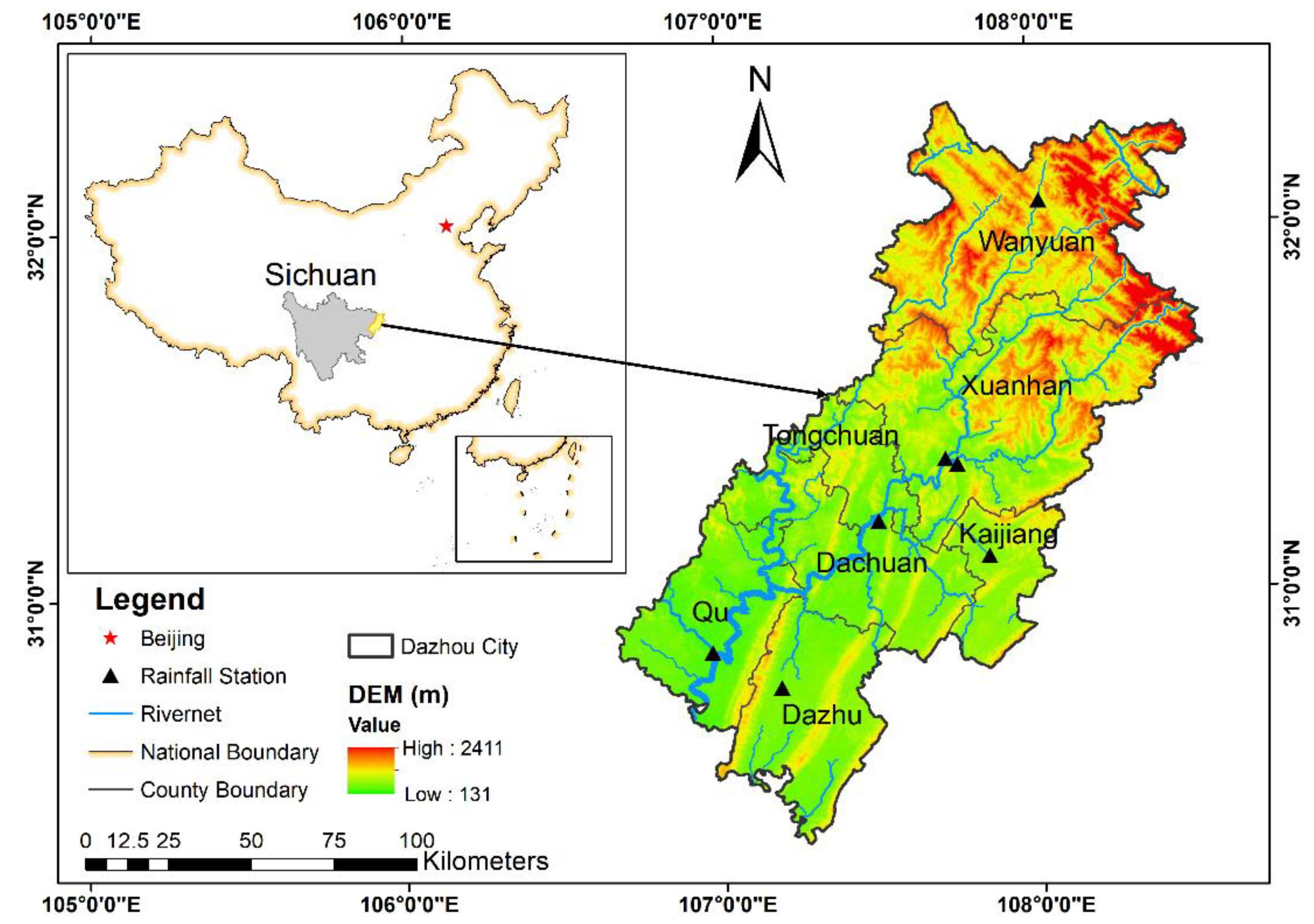
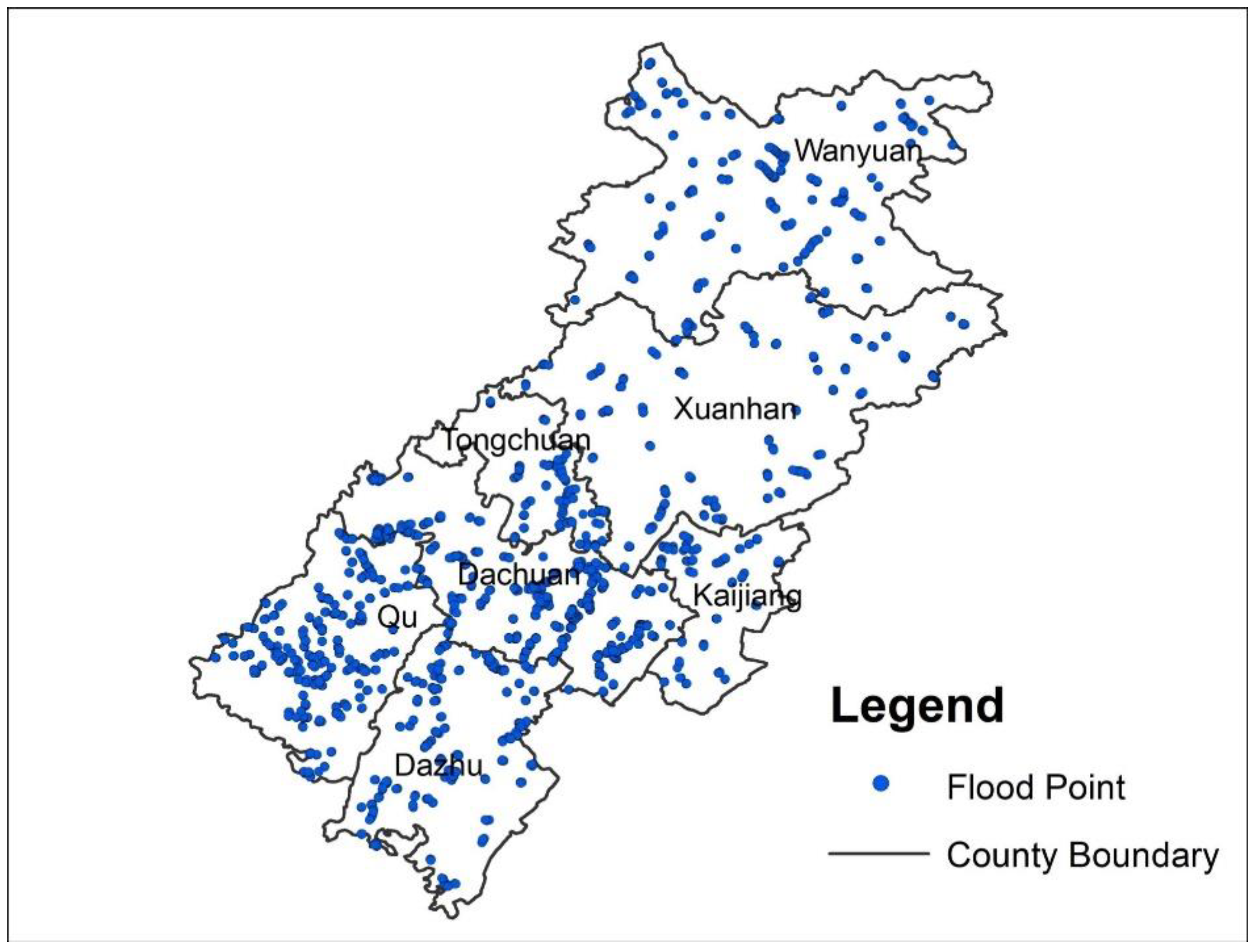
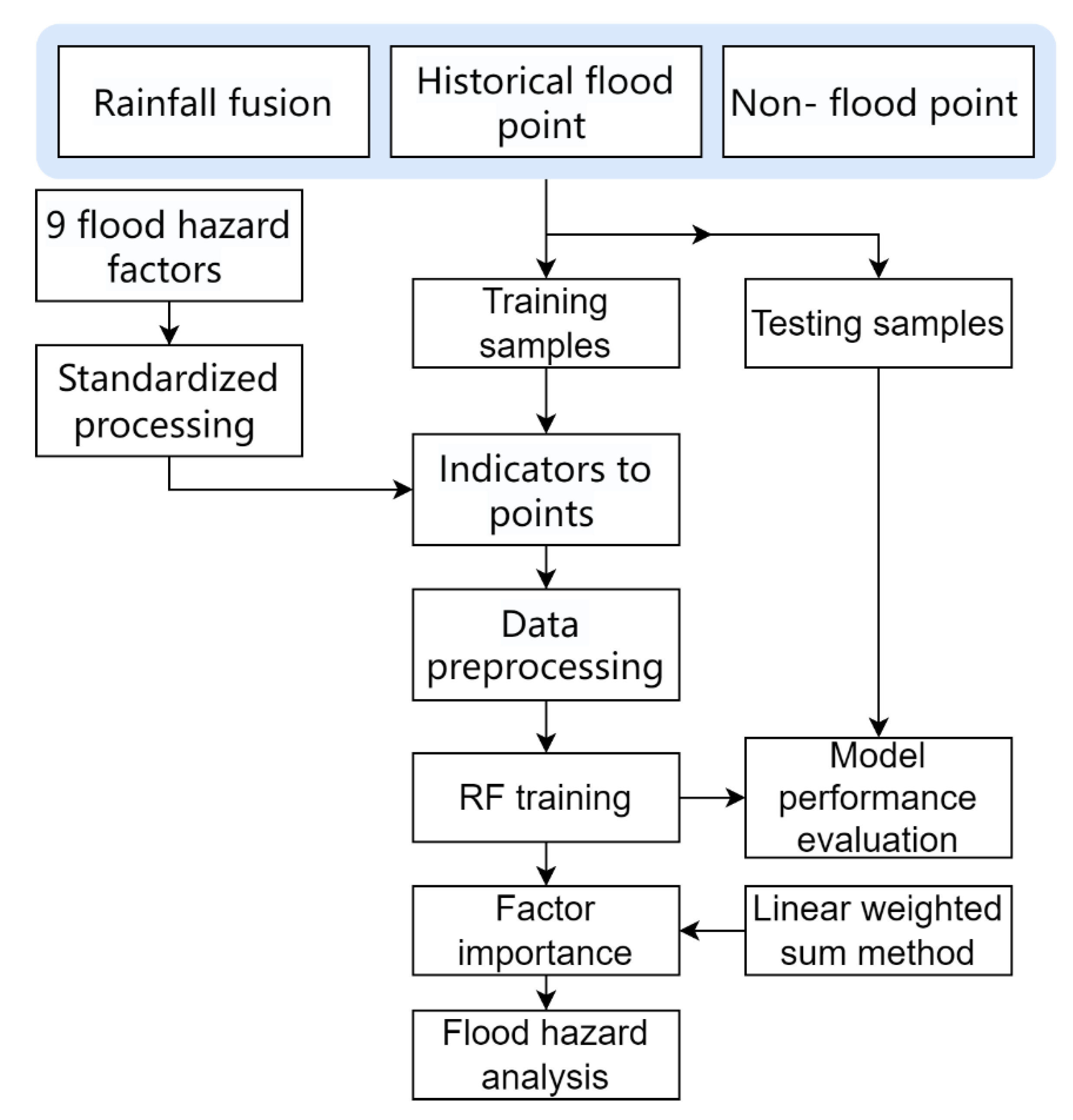
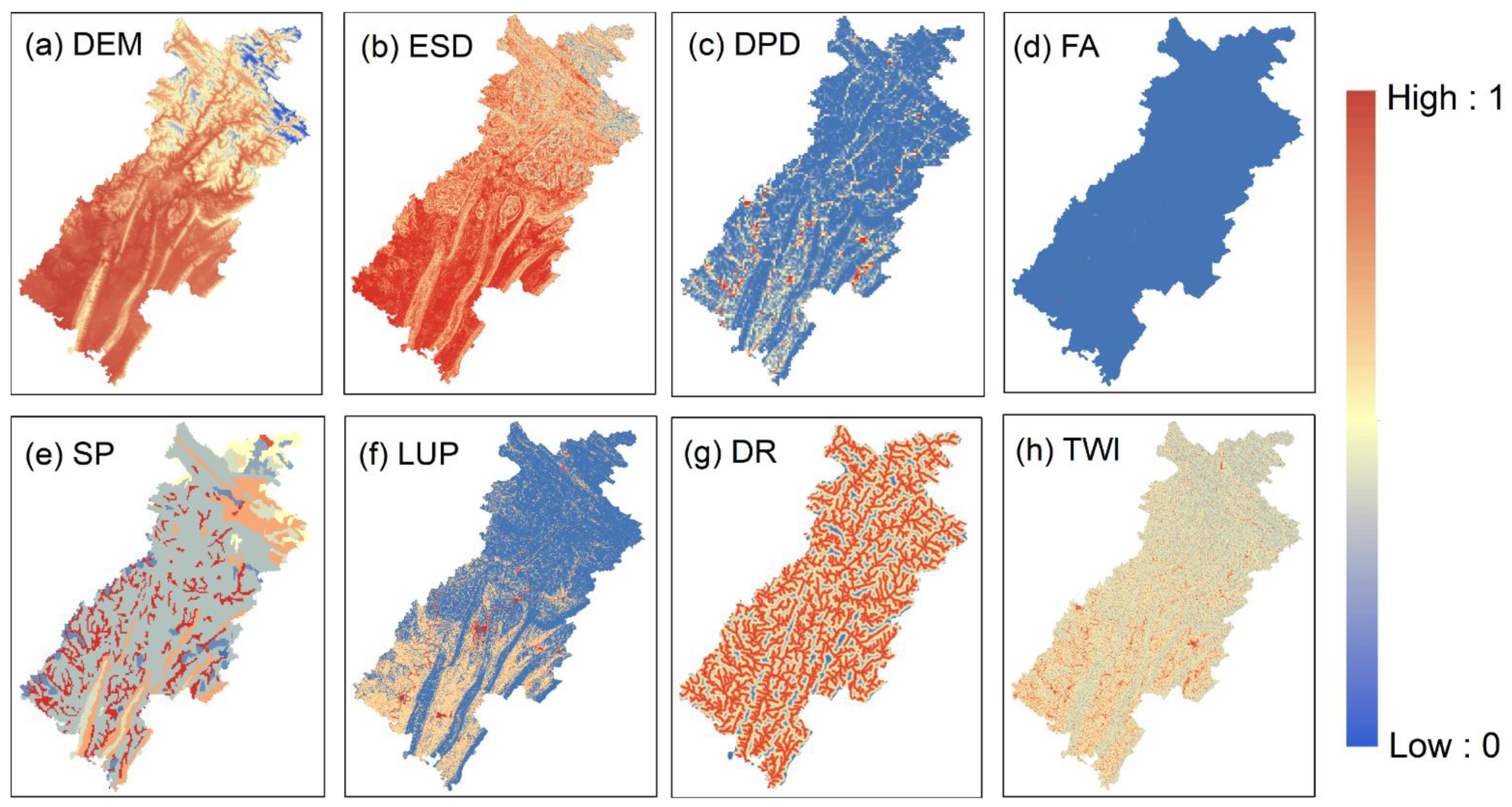
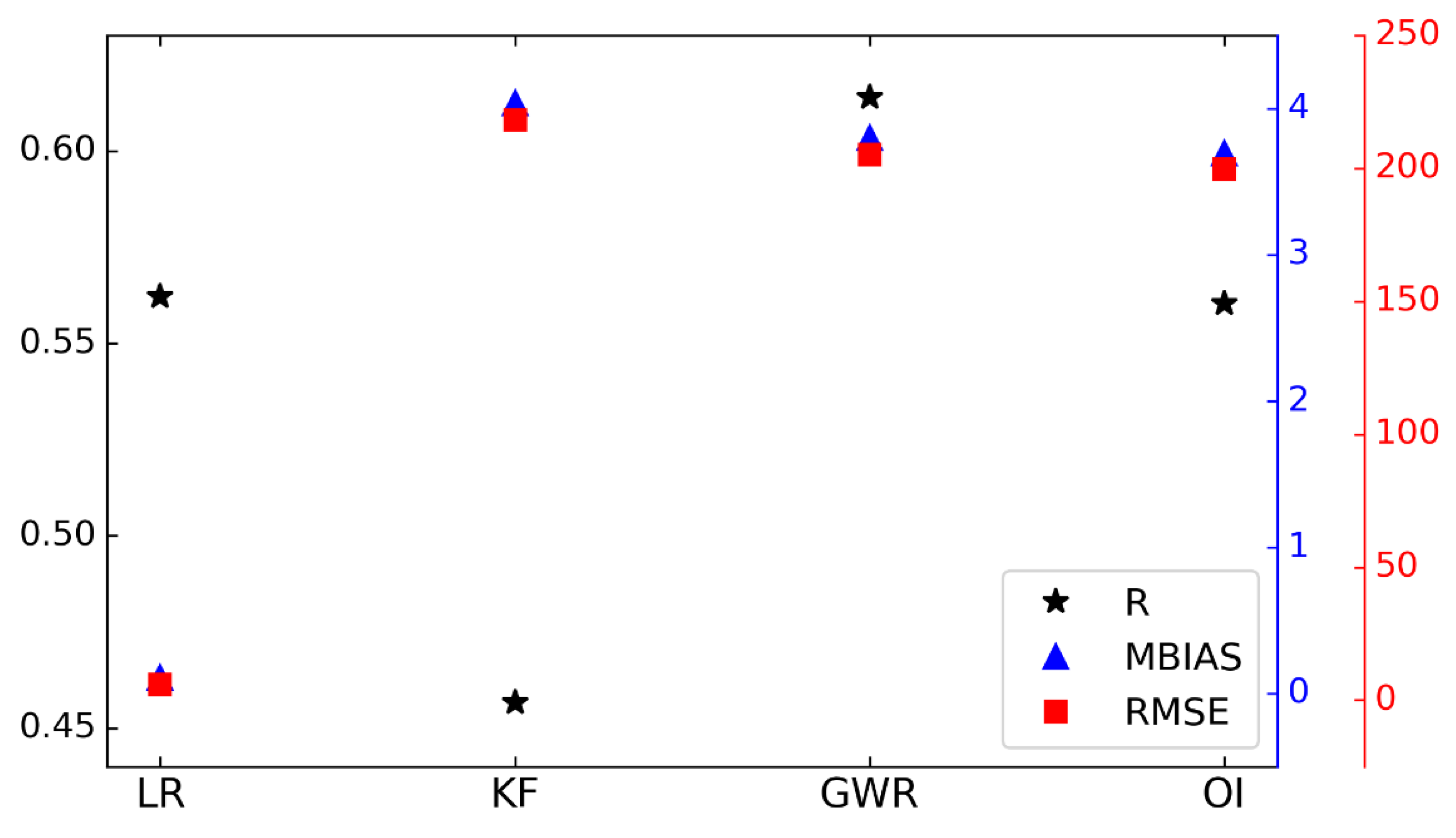
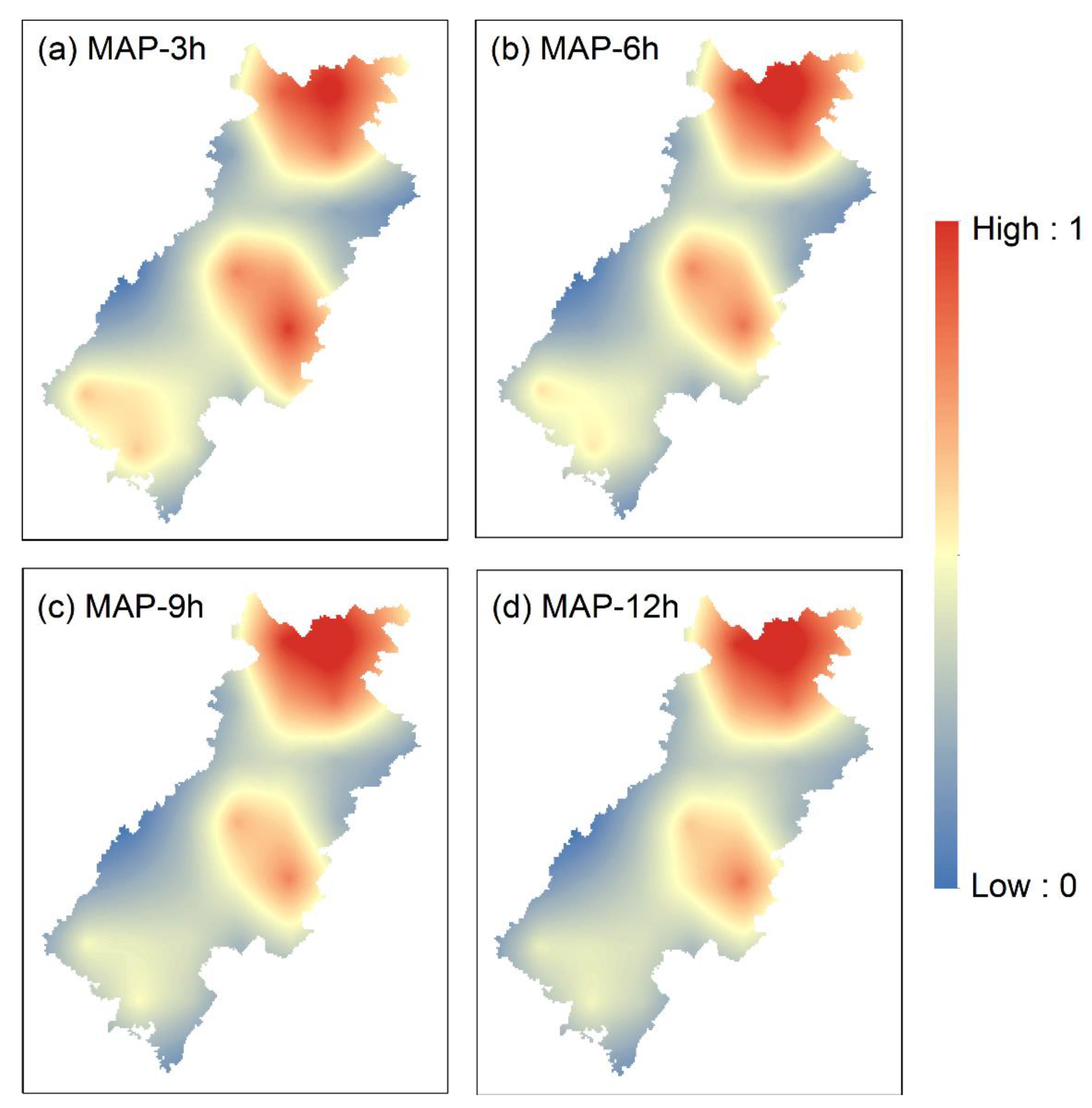
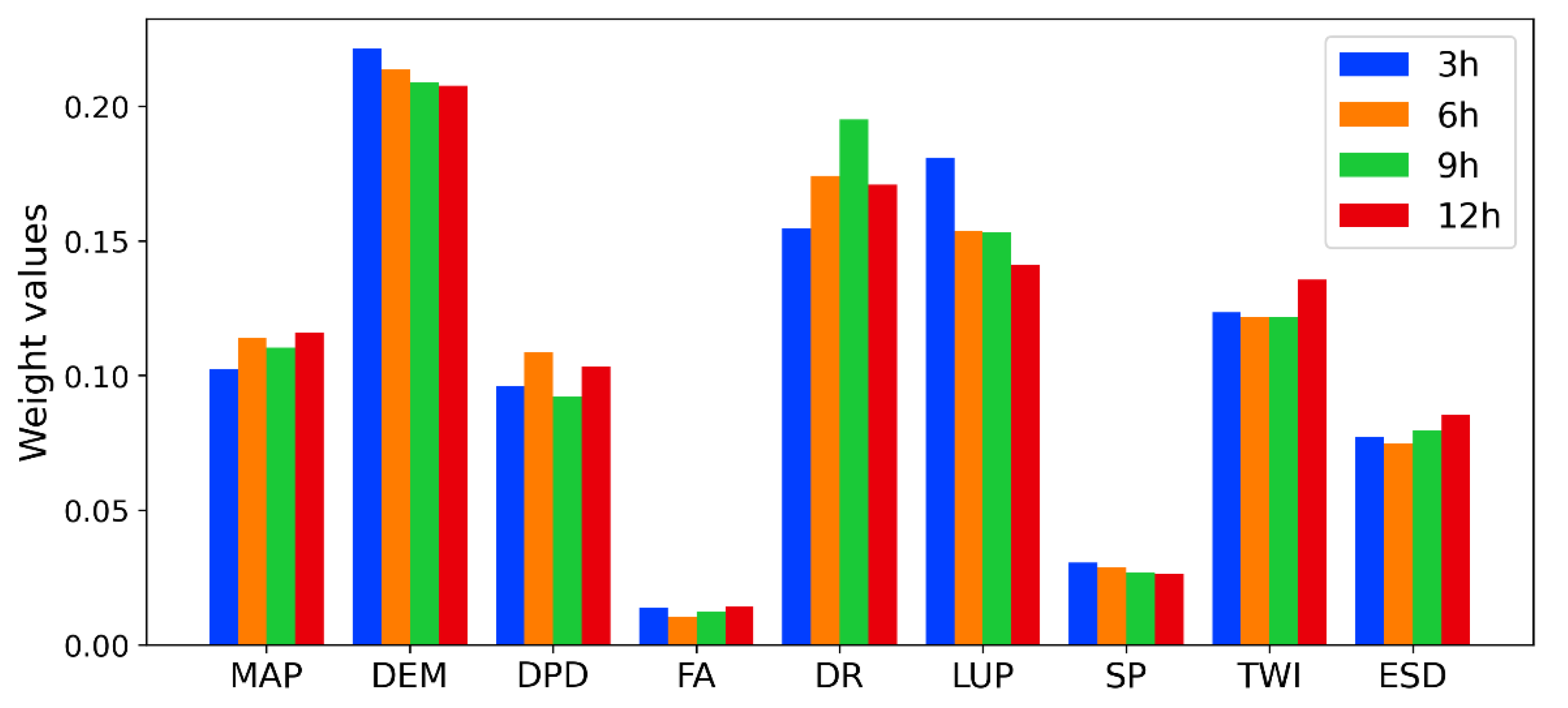
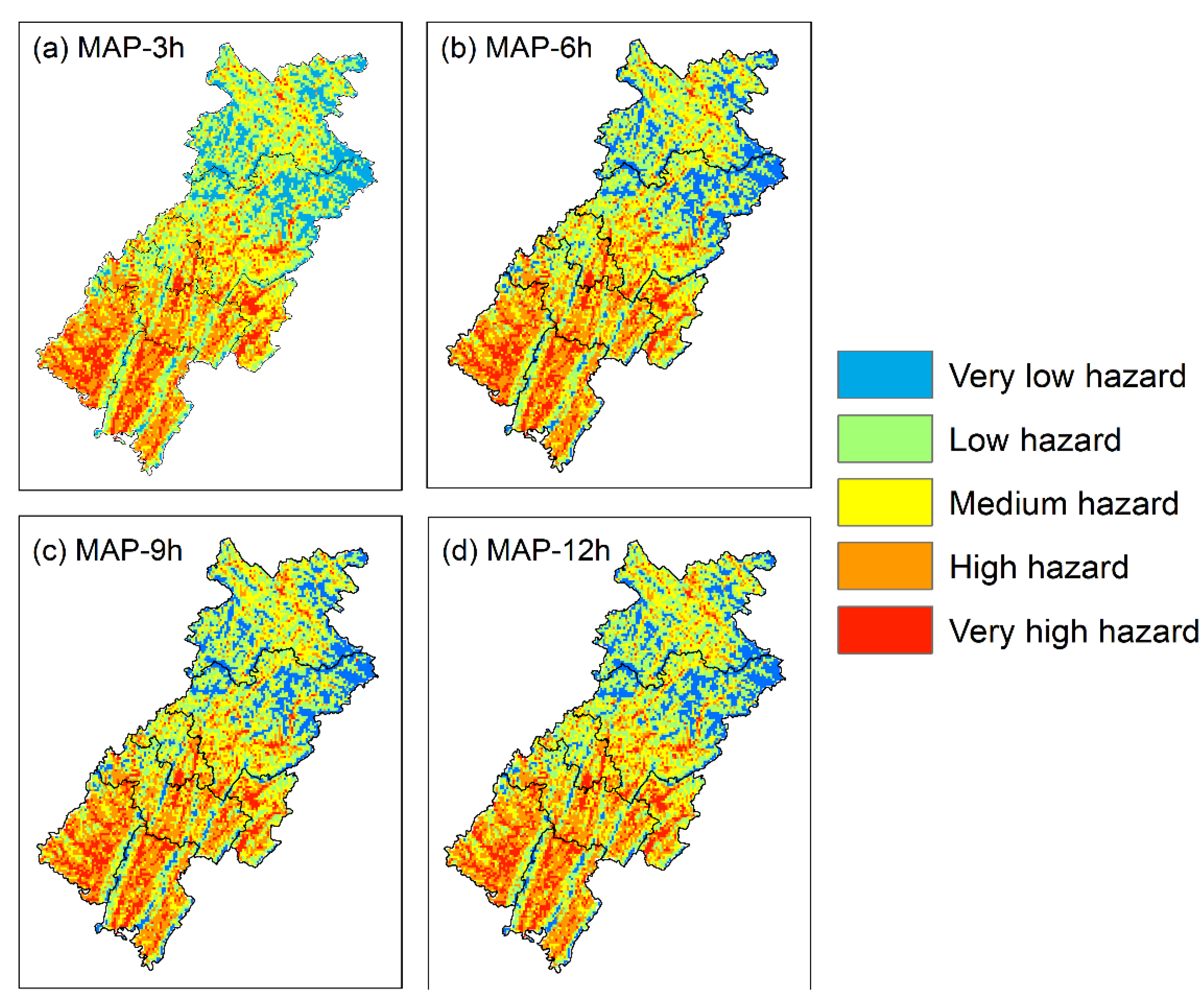
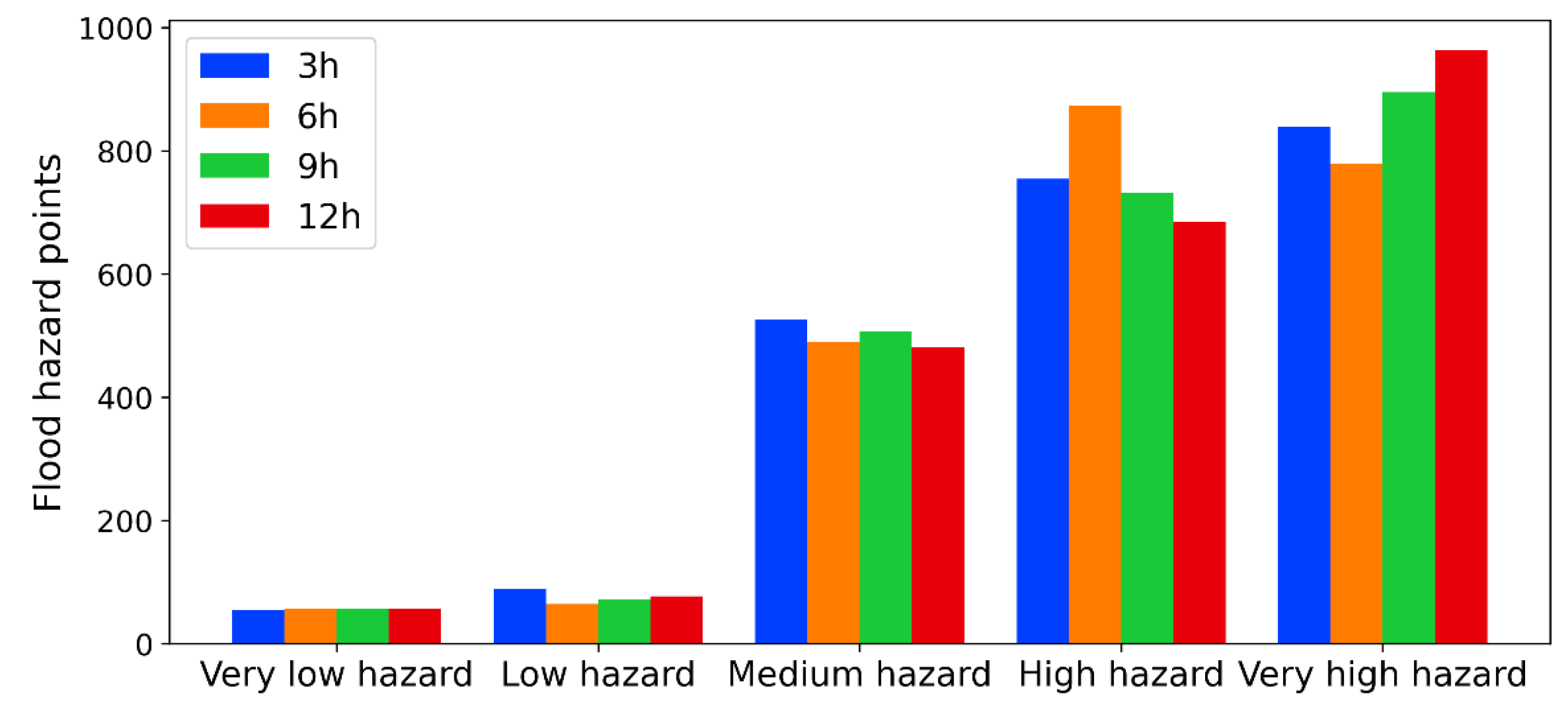
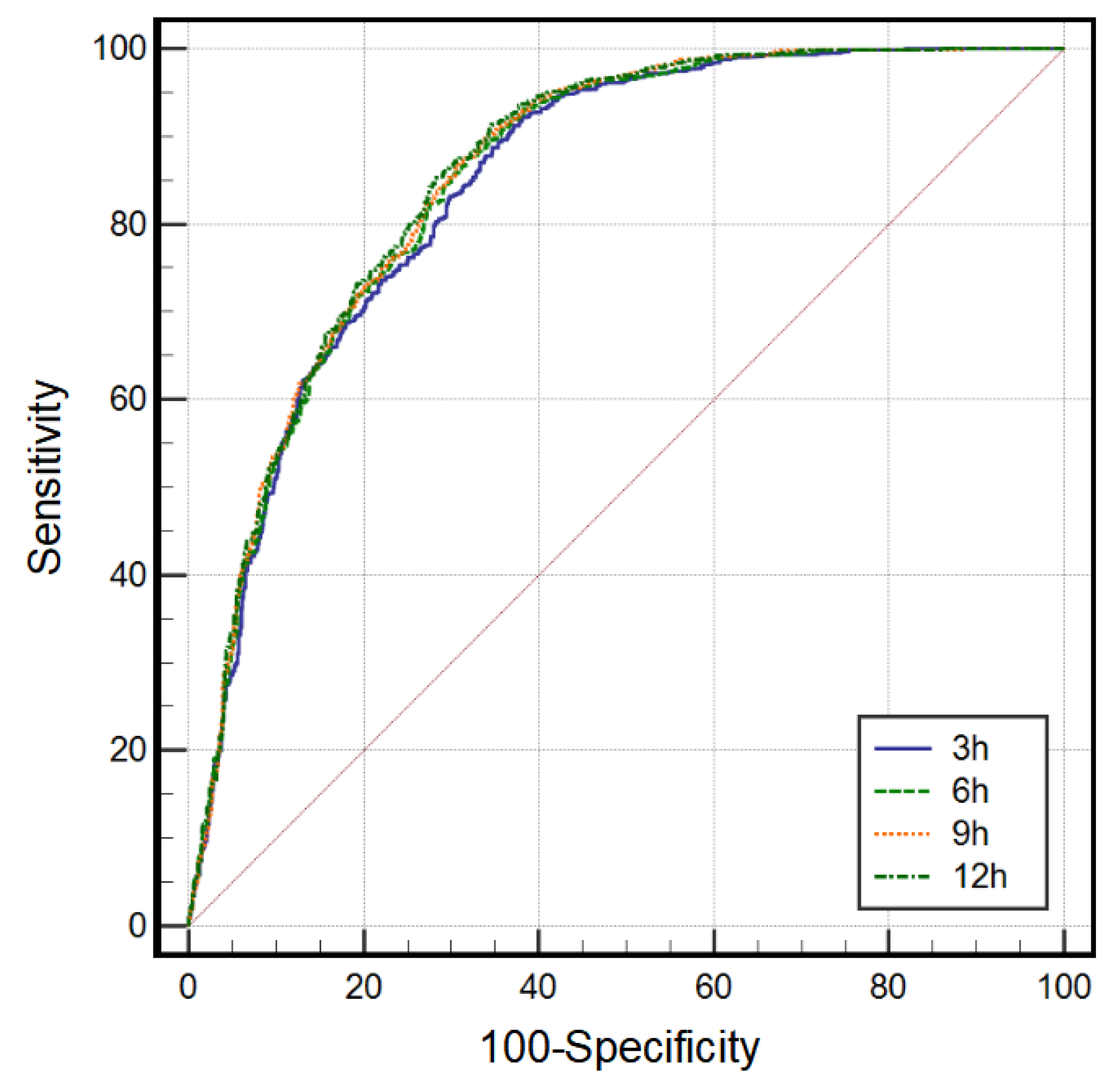
| Factor Type | Specific Factors | Abbreviation |
|---|---|---|
| Topographic | Digital Elevation Model | DEM |
| Elevation Standard Deviation | DSD | |
| Depression Point Density | DPD | |
| Hydrological | Flow Accumulation | FA |
| Soil Permeability | SP | |
| Land Use | LU | |
| Distance to River | DR | |
| Topographic Wetness Index | TWI | |
| Precipitating | Maximum Precipitation | MAP |
| Soil Texture | Haplic Alisols | Cumulic Anthrosols | Eutric Cambisols | Dystric Cambisols | Rendzic Leptosols | Haplic Luvisols | Chromic Luvisols | Gleyic Luvisols | Eutric Regosols | Calcaric Regosols | Water Bodies |
|---|---|---|---|---|---|---|---|---|---|---|---|
| Soil texture code | 25 | 48 | 62 | 63 | 100 | 106 | 108 | 113 | 156 | 157 | 198 |
| Soil permeability (SP) | 4 | 1 | 9 | 8 | 5 | 6 | 7 | 2 | 3 | 10 | 11 |
| Land Use Types | Farmland | Forest | Grassland | Shrubland | Wetland | Water | Artificial Land | Nudation | Sparse Vegetation |
|---|---|---|---|---|---|---|---|---|---|
| Runoff coefficients | 0.6 | 0.15 | 0.2 | 0.18 | 0.5 | 1 | 0.95 | 0.7 | 0.9 |
Publisher’s Note: MDPI stays neutral with regard to jurisdictional claims in published maps and institutional affiliations. |
© 2022 by the authors. Licensee MDPI, Basel, Switzerland. This article is an open access article distributed under the terms and conditions of the Creative Commons Attribution (CC BY) license (https://creativecommons.org/licenses/by/4.0/).
Share and Cite
Liu, L.; Zhou, L.; Ao, T.; Liu, X.; Shu, X. Flood Hazard Analysis Based on Rainfall Fusion: A Case Study in Dazhou City, China. Remote Sens. 2022, 14, 4843. https://doi.org/10.3390/rs14194843
Liu L, Zhou L, Ao T, Liu X, Shu X. Flood Hazard Analysis Based on Rainfall Fusion: A Case Study in Dazhou City, China. Remote Sensing. 2022; 14(19):4843. https://doi.org/10.3390/rs14194843
Chicago/Turabian StyleLiu, Lingxue, Li Zhou, Tianqi Ao, Xing Liu, and Xiaolong Shu. 2022. "Flood Hazard Analysis Based on Rainfall Fusion: A Case Study in Dazhou City, China" Remote Sensing 14, no. 19: 4843. https://doi.org/10.3390/rs14194843
APA StyleLiu, L., Zhou, L., Ao, T., Liu, X., & Shu, X. (2022). Flood Hazard Analysis Based on Rainfall Fusion: A Case Study in Dazhou City, China. Remote Sensing, 14(19), 4843. https://doi.org/10.3390/rs14194843











